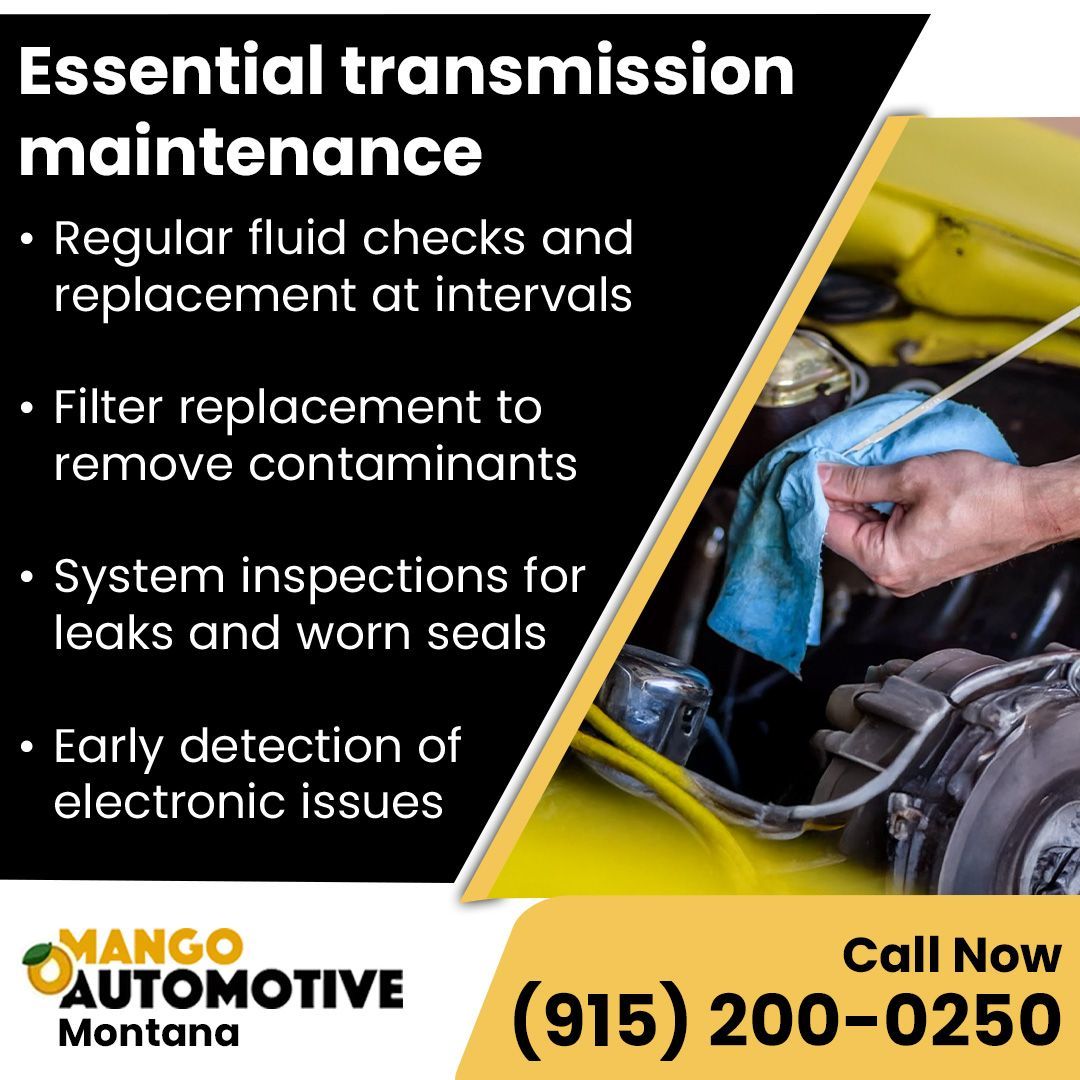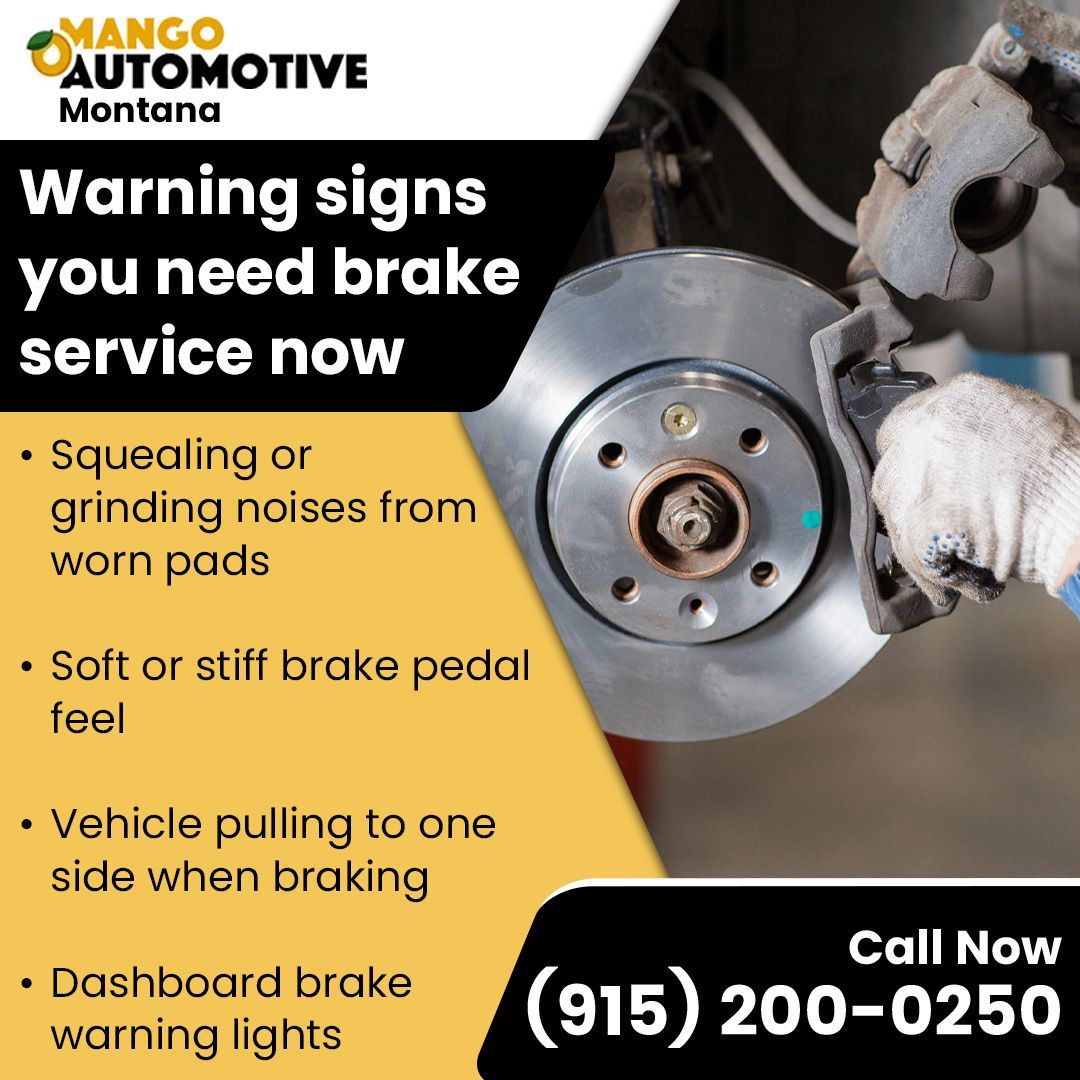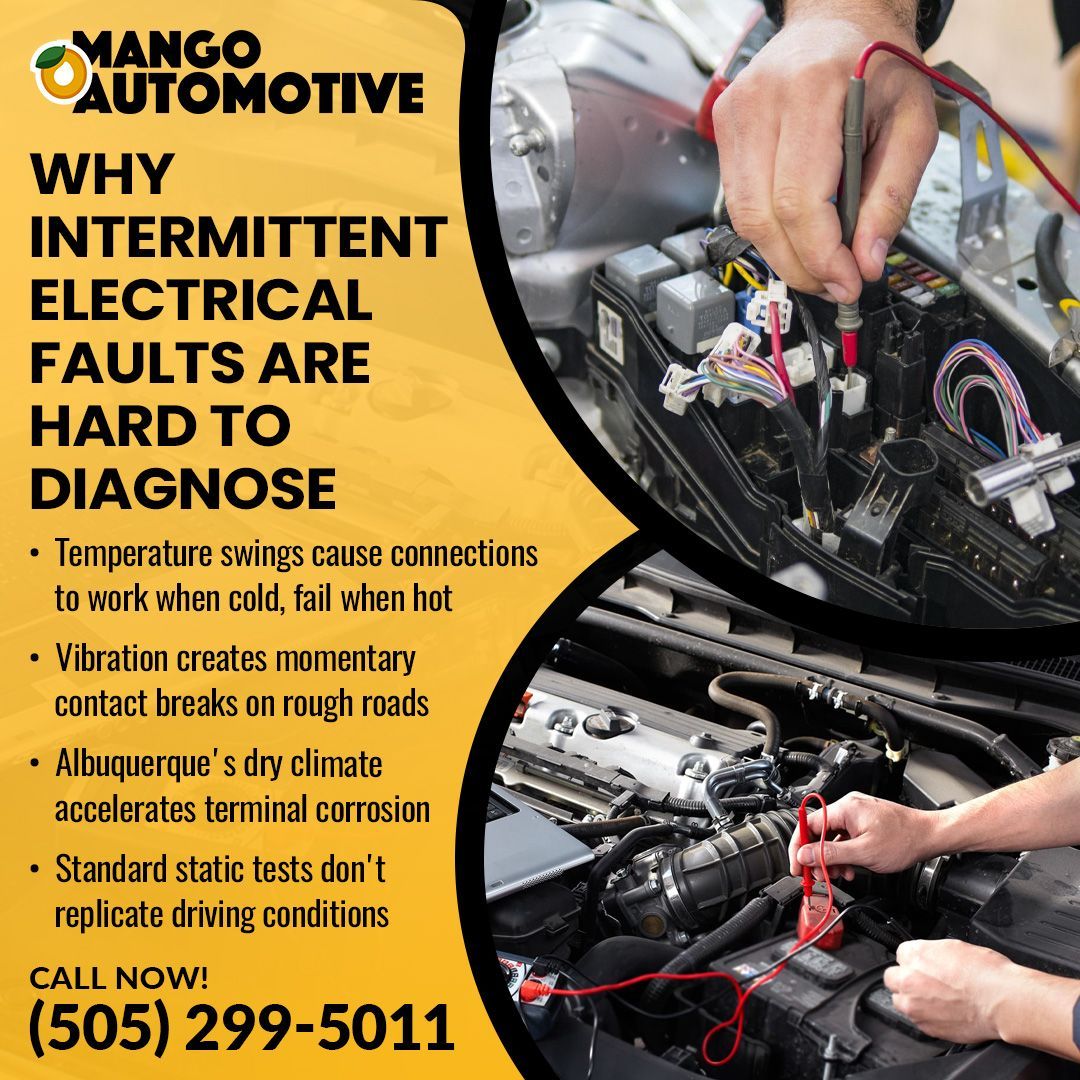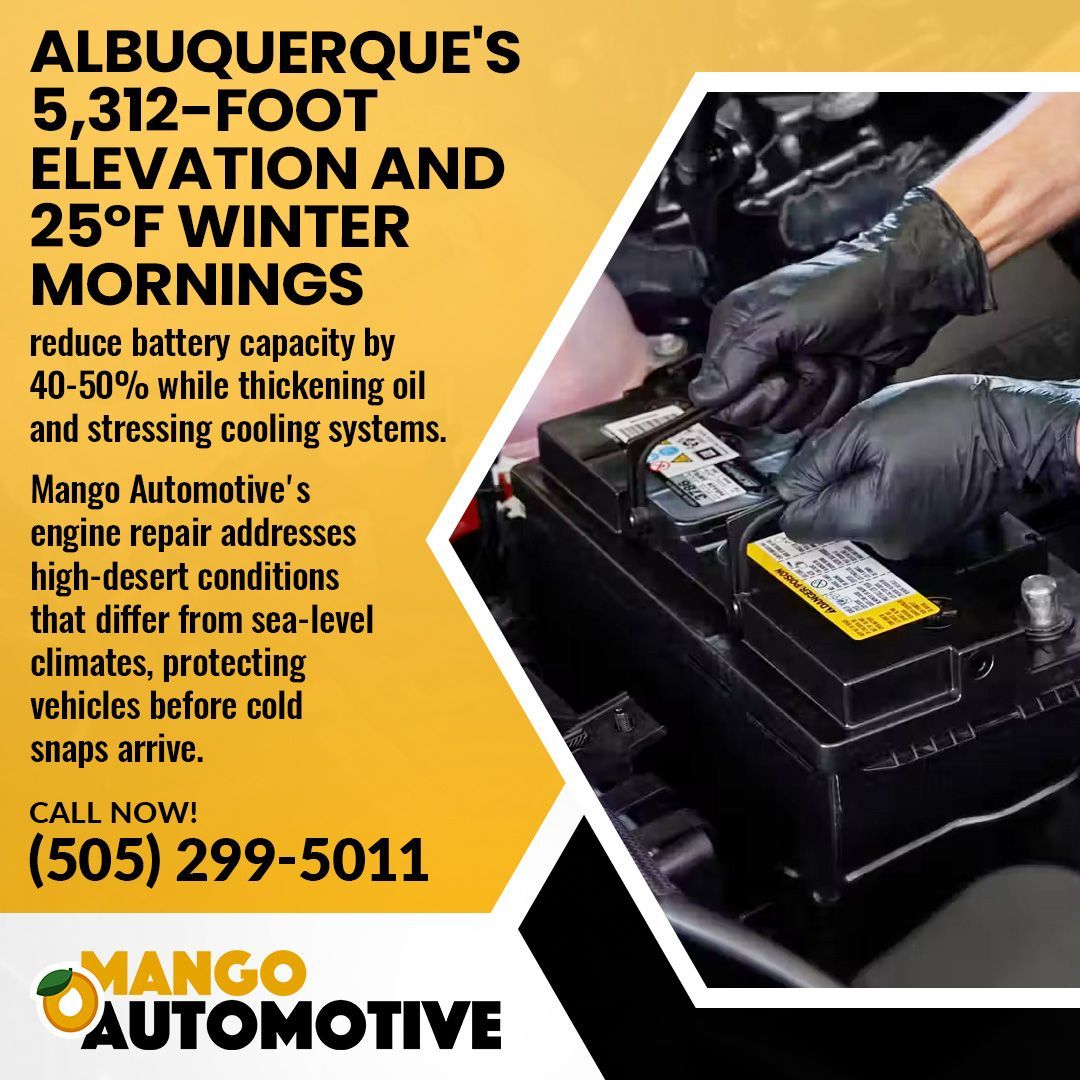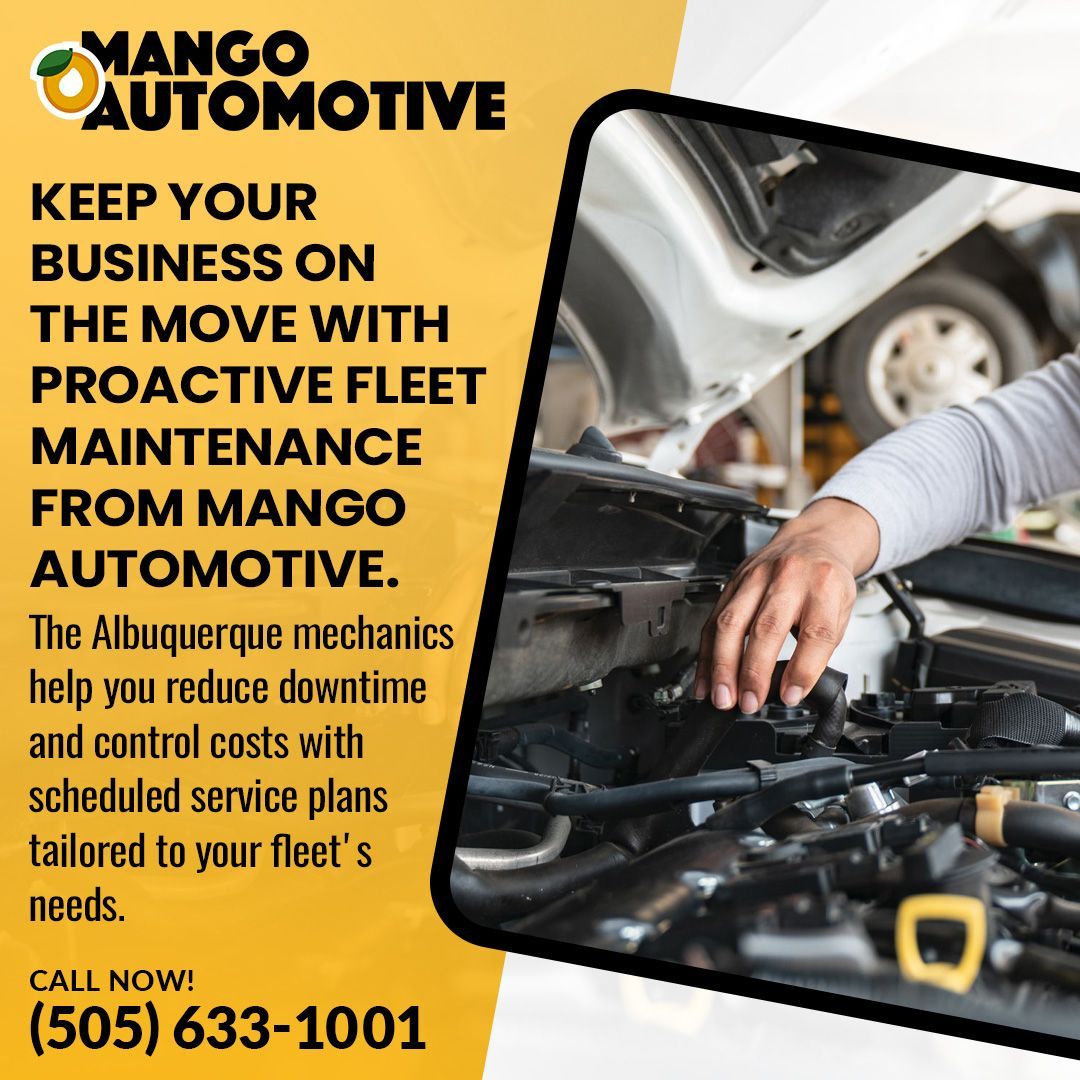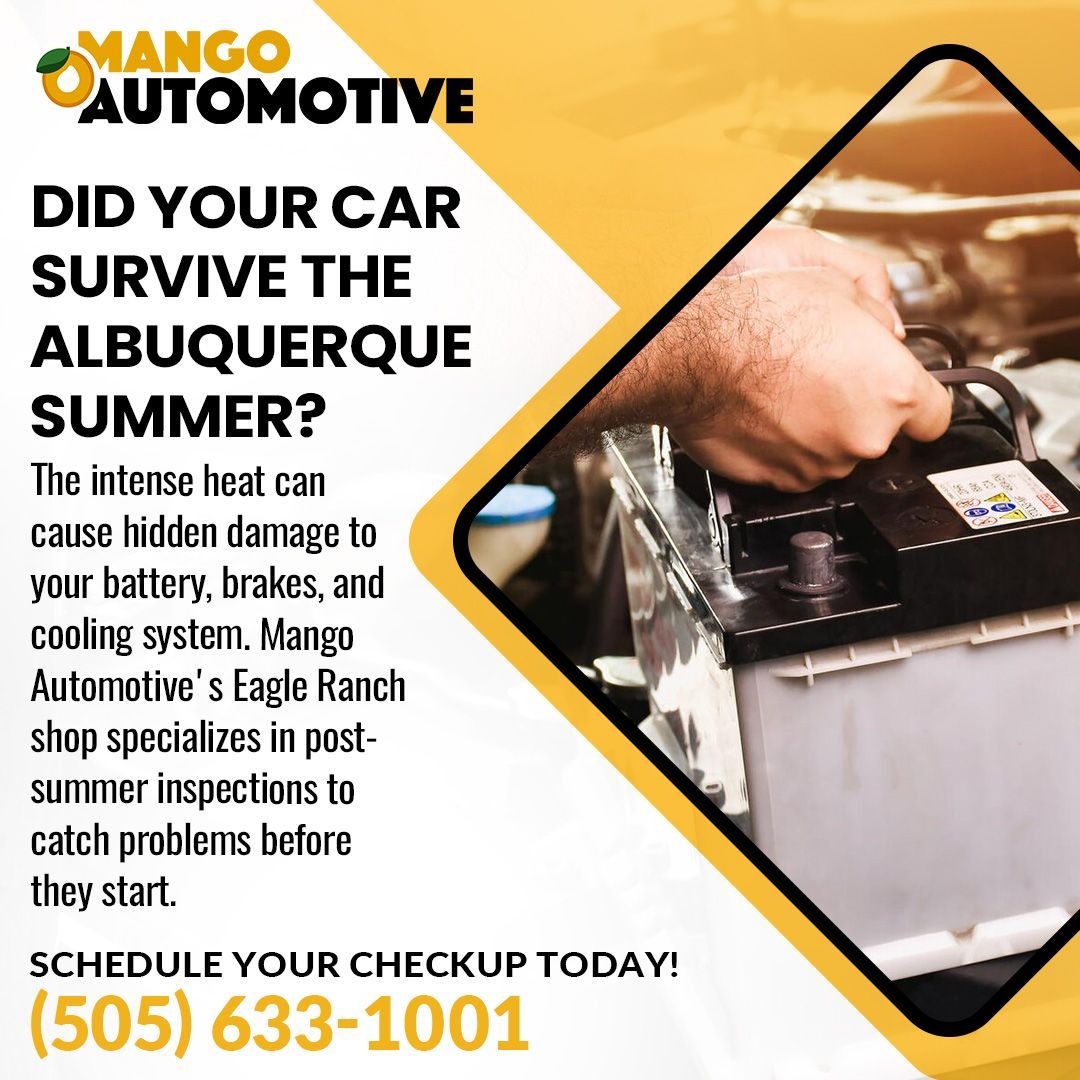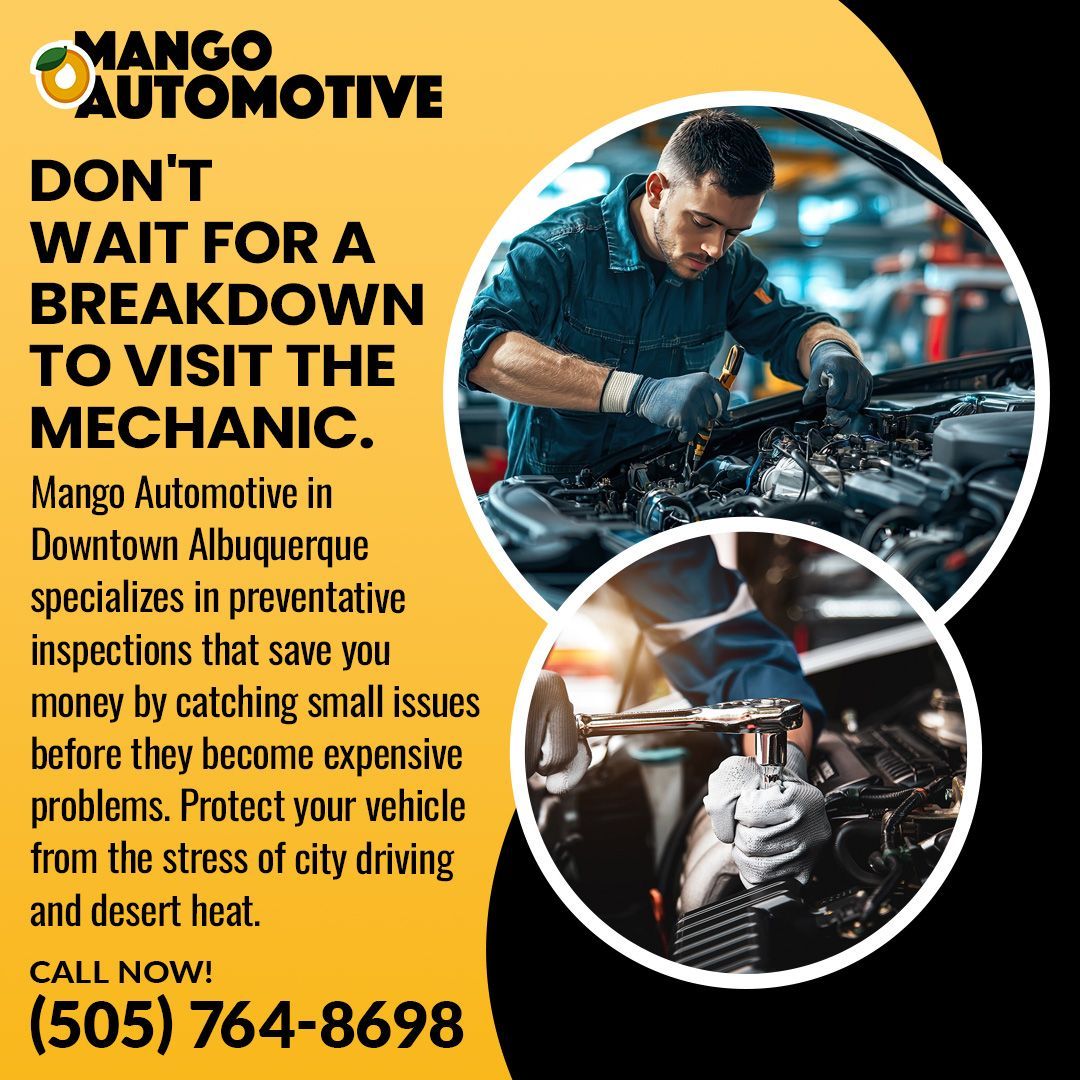Suspension System Warning Signs: Expert Tips from Auto Mechanics in Albuquerque
Your vehicle's suspension system absorbs road impacts and maintains stability while driving through Albuquerque's streets. This complex network of components works continuously to keep your ride smooth and your vehicle controllable. When suspension parts begin to fail, your car will display specific warning signs that require immediate professional attention.
Suspension system failure can affect vehicle safety and performance in multiple ways. At
Mango Automotive (Downtown), our experienced
auto mechanics in Albuquerque understand how local driving conditions affect your vehicle's suspension system and can identify problems before they become dangerous or costly.
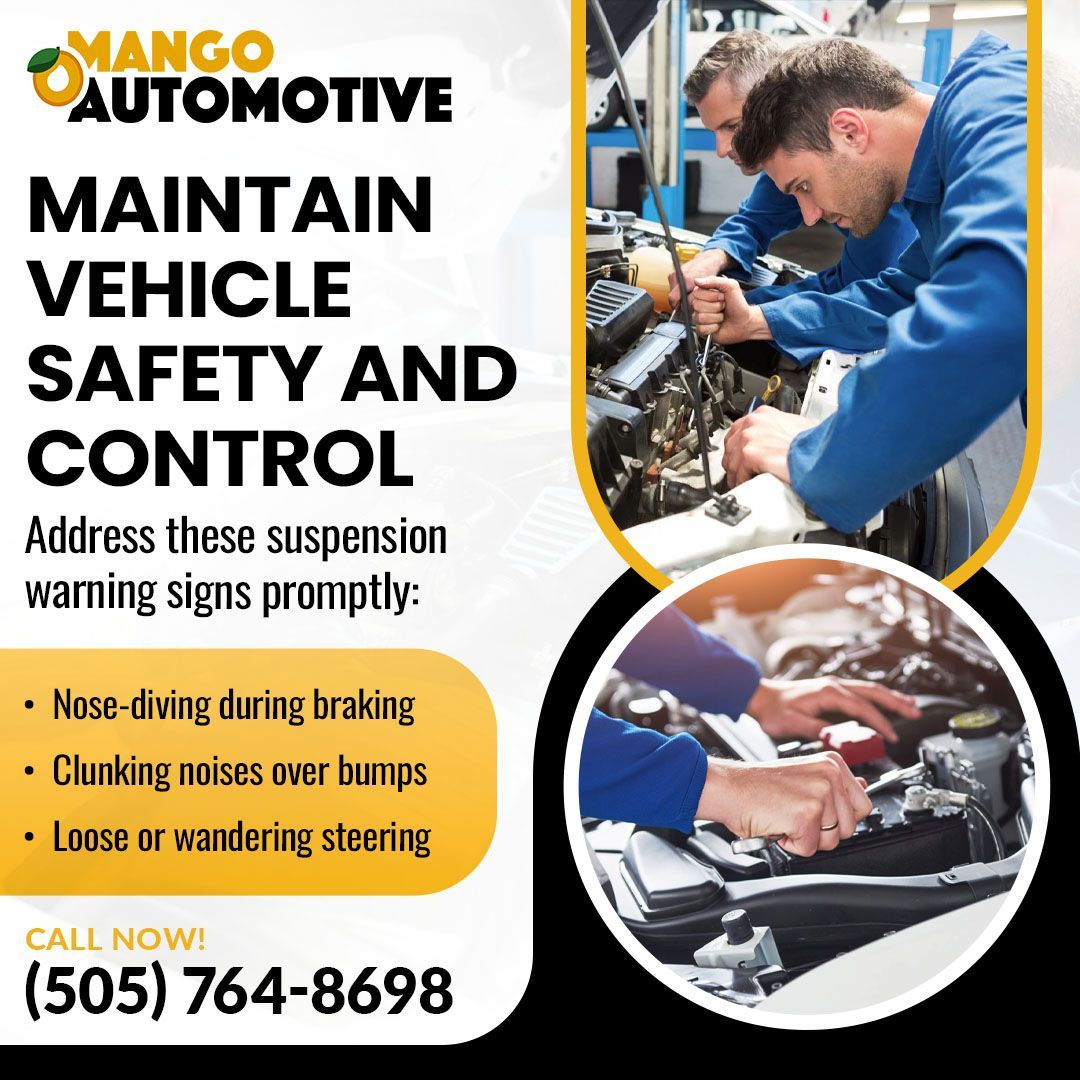
Suspension System Components and Functions
The suspension system is made up of shock absorbers, struts, springs, control arms, ball joints, and tie rods. Each component plays a specific role in maintaining vehicle stability and ride comfort.
Shock absorbers (also called dampers) control the bounce and rebound motion of your vehicle's springs. The spring and shock absorber are combined into one unit by the strut. They also serve as a structural component of the suspension. Control arms connect the wheel hub and the vehicle frame, allowing controlled up-and-down movement.
Springs support the vehicle's weight and maintain proper ride height. Ball joints provide pivot points that allow wheels to turn while moving up and down. The wheels and steering system are connected by tie rods. These rods transmit the steering input to change wheel direction.
These components work together as an integrated system. When one part fails, it places additional stress on remaining components, often leading to cascading failures if not addressed promptly.
Common Signs Your Suspension Needs Repair
Multiple warning signs indicate when suspension components require professional attention from a mechanic near you. These symptoms often develop gradually but become more noticeable as wear progresses. Early recognition allows for timely repairs that maintain vehicle safety and performance.
Excessive Bouncing After Road Impacts
Your vehicle should settle immediately after hitting bumps or potholes. Continued bouncing indicates worn shock absorbers or struts that can no longer control spring oscillations effectively.
Test this by pressing down firmly on each corner of your parked vehicle. Release pressure and observe the response. A properly functioning suspension will return to its normal position with minimal bouncing. If the vehicle bounces more than twice, the shocks or struts at that corner need replacement.
This bouncing occurs because worn shocks lose their ability to dampen spring movement. Without proper damping, springs continue to oscillate after road impacts, making handling unpredictable during emergency maneuvers.
Vehicle Pulling During Straight-Line Driving
A properly aligned vehicle with functioning suspension travels straight with minimal steering input. When your car consistently pulls to one side, suspension components may be worn or damaged.
Several suspension issues cause pulling behavior. Worn control arm bushings allow excessive wheel movement. Uneven shock absorber wear creates imbalanced suspension forces. Failed ball joints permit irregular wheel positioning that affects tracking.
This pulling differs from alignment issues or tire pressure problems. Suspension-related pulling often feels more severe and may be accompanied by other symptoms like noise or vibration. Check tire pressure first to eliminate the most common cause.
Front-End Diving During Braking
Normal braking should feel controlled without excessive forward vehicle movement. When the front end dips dramatically during braking, worn shock absorbers or struts cannot properly control weight transfer.
This condition, called brake dive, occurs when suspension components lose their ability to resist compression forces. During braking, the vehicle's weight shifts forward. Functioning suspension components control this weight transfer gradually. Worn components allow rapid, uncontrolled forward diving motion that increases stopping distances.
Uneven Tire Wear Patterns
Tires should wear evenly across their surface when suspension geometry remains correct. Irregular wear patterns indicate suspension components that cannot maintain proper wheel positioning.
Cupping wear appears as scalloped depressions around the tire circumference from wheels bouncing due to worn shocks or struts. Feathering wear creates smooth wear on one edge and sharp edges on the opposite side, typically from toe alignment issues caused by suspension wear.
Shoulder wear affects the outer or inner tire edges. One-sided wear occurs when suspension components allow the wheel to tilt excessively inward or outward. These patterns reduce tire life while creating safety hazards through reduced traction.
Unusual Noises from Suspension Components
Properly functioning suspension operates quietly during normal driving conditions. Clunking, squeaking, or grinding sounds indicate worn or damaged suspension parts.
Clunking noises over bumps result from worn ball joints, control arm bushings, or sway bar links. These components develop play as their protective coverings deteriorate, allowing metal-to-metal contact. Squeaking sounds often indicate worn bushings that no longer provide smooth articulation between moving parts.
Front-end clunking during turns points to ball joint problems. Rear-end noise over bumps suggests shock absorber or spring issues. Grinding noises suggest more severe wear requiring immediate attention to prevent complete component failure.
Steering Difficulties at Various Speeds
Steering should feel responsive and predictable at all driving speeds. Difficulty turning, wandering, or loose steering often indicates suspension system problems. Worn tie rod ends create play in the steering system, making the vehicle feel loose or requiring constant correction to maintain straight-line travel. This condition becomes particularly noticeable during highway driving or when parking in tight spaces in Albuquerque.
Ball joint wear affects steering precision and may cause the steering wheel to vibrate or feel unstable. Control arm bushing deterioration allows excessive wheel movement that translates into steering irregularities.
Vehicle Height Variations When Parked
Your vehicle should sit level when parked on flat surfaces. One corner sitting lower than the others indicates spring or strut failure at that location. Coil springs can break or sag over time, particularly in vehicles that frequently carry heavy loads or encounter rough road conditions. Strut failure allows the vehicle to settle lower as the unit loses its ability to support vehicle weight.
This sagging becomes visible when comparing wheel well gaps around the vehicle. The space between the tire and the body panel should appear uniform on all four corners. Significant differences indicate suspension failure requiring immediate attention from auto mechanics in Albuquerque.
Fluid Leaks Around Suspension Components
Visible fluid leaks near wheels or suspension components indicate internal seal failures. These leaks typically appear as oily residue on shock absorbers, struts, or surrounding areas. Shock absorbers and struts contain hydraulic fluid that dampens spring oscillations. When internal seals fail, this fluid leaks out, reducing the component's effectiveness.
Fresh leaks appear wet and oily, while older leaks create dark stains on the component housing. Leaking suspension components lose their ability to control vehicle movement effectively, leading to increased bouncing and reduced handling precision.
When you notice any of these warning signs, consulting a qualified
mechanic near you becomes important for proper diagnosis and safe repairs. Delaying suspension repairs often leads to additional damage to tires, steering components, and brakes. The sooner you address these issues, the more you protect your vehicle's overall performance and your safety on Albuquerque's roads.
How Albuquerque Roads Affect Your Suspension
Albuquerque's high desert environment and urban driving conditions create challenges for suspension systems. Temperature extremes cause rubber components to deteriorate faster than in moderate climates. Daily temperature variations between hot days and cool nights stress seals and bushings repeatedly.
Stop-and-go traffic places repeated stress on suspension components through constant weight transfer during braking and acceleration. Construction zones around the city create temporary rough surfaces that test suspension durability beyond normal wear patterns.
The combination of altitude, temperature variation, and urban driving patterns makes regular suspension inspection particularly important for local drivers. Experienced auto mechanics in Albuquerque understand these conditions and adjust maintenance schedules accordingly to prevent premature failures.
Preventive Maintenance for Suspension Systems
Regular inspection and preventive maintenance extend suspension component life and maintain vehicle safety. Most suspension parts last 75,000 to 100,000 miles under normal driving conditions, though local conditions may reduce this timeframe. Monthly visual inspections can identify leaks, damage, or unusual wear before components fail completely. Look for oil stains under parked vehicles, unusual tire wear patterns, and listen for new sounds during driving.
Avoiding potholes when possible and driving at appropriate speeds over rough surfaces reduces suspension stress. Proper tire inflation and regular rotation help suspension components maintain correct geometry and reduce wear.
Professional Suspension Services at Mango Automotive
Suspension problems often catch drivers off guard because the symptoms develop gradually over time. Many customers visit our shop after experiencing rough rides or steering issues, not realizing these problems started months earlier with minor bouncing or subtle pulling. Our team of skilled mechanics in Downtown Albuquerque has seen how unique conditions in the region accelerate suspension wear, which helps them provide early detection and preventive maintenance.
Expert Suspension Diagnosis and Repair
Our mechanics in Downtown provide thorough diagnosis using modern equipment and repair procedures that restore proper vehicle performance. We focus on identifying root causes rather than just treating symptoms, preventing recurring problems, and providing long-lasting solutions.
Our diagnostic process begins with road testing to identify specific symptoms and their severity. We measure suspension geometry and component wear precisely, and identify the exact failure points rather than guessing at potential problems.
Modern vehicles use complex suspension designs that require manufacturer-specific repair procedures. Our team stays current with technical training and uses correct parts and installation methods to maintain safety systems and warranty compliance.
Quality Parts and Proven Techniques
We use quality replacement parts and proven repair techniques that meet manufacturer specifications. Professional repair includes replacing worn components in pairs to maintain balanced performance, preventing premature failure of new parts and maintaining vehicle stability.
Our repairs come with a
60-month/60,000-mile warranty that demonstrates our confidence in the repairs we perform. This coverage protects your vehicle and provides peace of mind knowing that our work meets professional standards.
Convenient Service Experience
Our comfortable waiting area and customer-focused approach make suspension service as stress-free as possible. We work efficiently to minimize the time your vehicle is out of service while performing thorough work that prevents future problems. Our mechanics in Downtown Albuquerque communicate clearly about findings and repair options, helping you make informed decisions about your vehicle's maintenance.
We understand that reliable transportation is important for your daily life. Our scheduling accommodates busy schedules, and we provide clear timelines for completion so you can plan accordingly.
Frequently Asked Questions About Suspension Repairs
How long do suspension components typically last in Albuquerque?
Most suspension parts last 75,000 to 100,000 miles under normal conditions, but Albuquerque's conditions may reduce this timeframe. High desert temperatures, altitude changes, and urban driving patterns create additional stress on suspension components.
Temperature extremes cause rubber bushings and seals to deteriorate faster than in moderate climates. Daily commuting through stop-and-go traffic accelerates wear on shock absorbers and struts through repeated weight transfer cycles.
Can I drive with worn suspension components?
Driving with worn suspension is possible, but creates safety risks and leads to additional damage. Compromised suspension affects your vehicle's ability to handle emergency maneuvers and maintain tire contact with the road surface. Worn suspension components also accelerate tire wear, reduce braking effectiveness, and place extra stress on steering components. Continuing to drive with known suspension problems typically doubles repair expenses when secondary damage occurs.
How do I know if my suspension problem is serious?
Any suspension symptom that affects vehicle control requires immediate professional attention. Severe pulling to one side, excessive brake dive, or grinding noises indicate conditions that could compromise safety.
Gradual symptoms like minor bouncing or slight steering looseness allow time for scheduled repair appointments. However, rapid changes in vehicle behavior or new unusual noises warrant immediate inspection by auto mechanics in Albuquerque.
Should suspension components be replaced in pairs?
Yes, suspension components should typically be replaced in pairs to maintain balanced vehicle performance. Replacing only one shock absorber or strut creates uneven dampening that can affect handling and accelerate wear on the new component. Paired replacement prevents the new component from working harder to compensate for its worn counterpart, extending the life of both components.
Do suspension repairs affect wheel alignment?
Many suspension repairs require wheel alignment service to restore proper geometry. Replacing struts, control arms, or tie rods changes suspension positioning that directly affects wheel alignment angles. Proper alignment after suspension work prevents uneven tire wear and maintains vehicle tracking stability that the new components provide.
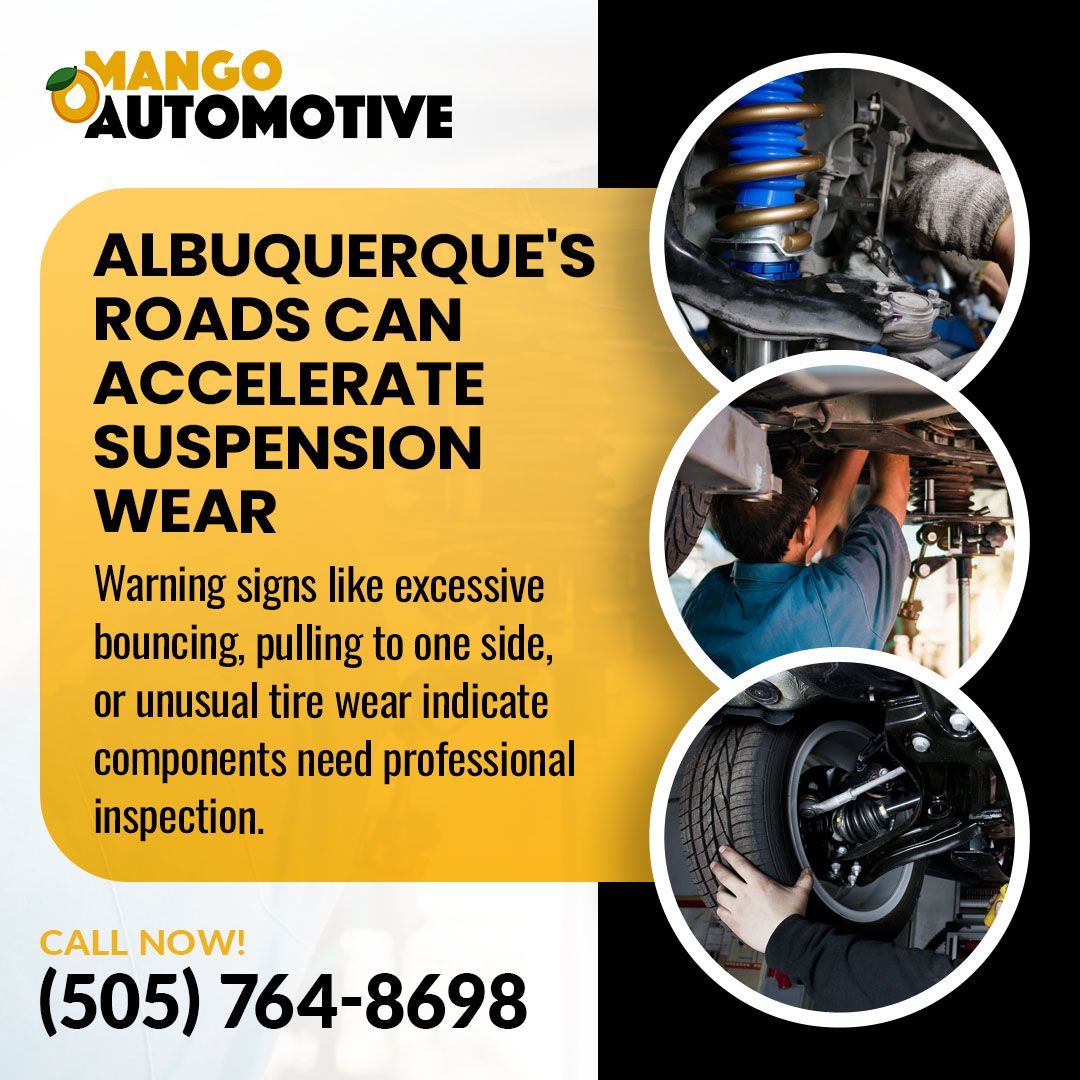
Schedule Professional Suspension Service with Your Trusted Mechanic in Downtown
Your vehicle's suspension system plays a critical role in safety, comfort, and overall driving performance. Ignoring warning signs leads to more expensive repairs and potentially dangerous driving conditions. Taking action at the first sign of trouble protects both your safety and your investment. When you choose an experienced mechanic near you for suspension repairs, you gain access to professional diagnosis, quality parts, and proven repair techniques.
Mango Automotive combines technical expertise with genuine care for our customers' transportation needs. Call us at
(505) 764-8698 to schedule your suspension inspection today. Early detection and professional repair keep your vehicle safe and comfortable while maintaining reliable transportation for your daily needs.
